First of all, you need a dress. BE SURE that you find one that comes down to at least the middle of the knee (or longer) when you try it on your subject.
If it’s any shorter, it won’t be long enough to tuck under the bum and meet together with snaps. (While the dress is on, tuck the front and back under the diaper area, to see if the front and back meets, with a little bit of overlap.) Also, to create the elastic casing for each leg, take a look at your dress and see if it has a hem that’s turned under.
My dress hem was turned under about an inch and was perfect for creating the little ruffle at the bottom of the elastic casing. But if your hem is more narrow, don’t worry, it will just act as a casing without the little ruffle at the bottom. If you dress doesn’t have a hem or the hem isn’t big enough for a casing, you’ll have to hem it up and create your own moving onto the next step. (Just be sure that the dress is long enough AFTER you hem it.)
Instructions:
1. To get started, you will be making a slight curve in the center bottom of the dress (both front and back sides). So find the exact center of the dress and then cut a slight curve out of the center front and back. REMEMBER that you need to leave some fabric along this curve for a seam allowance so the size of the curve will decrease by about a 1/4 inch along the entire curve. So don’t make it too big to begin with. (Mine was about 3 inches across along the bottom.)
If it’s any shorter, it won’t be long enough to tuck under the bum and meet together with snaps. (While the dress is on, tuck the front and back under the diaper area, to see if the front and back meets, with a little bit of overlap.) Also, to create the elastic casing for each leg, take a look at your dress and see if it has a hem that’s turned under.
My dress hem was turned under about an inch and was perfect for creating the little ruffle at the bottom of the elastic casing. But if your hem is more narrow, don’t worry, it will just act as a casing without the little ruffle at the bottom. If you dress doesn’t have a hem or the hem isn’t big enough for a casing, you’ll have to hem it up and create your own moving onto the next step. (Just be sure that the dress is long enough AFTER you hem it.)
Instructions:
1. To get started, you will be making a slight curve in the center bottom of the dress (both front and back sides). So find the exact center of the dress and then cut a slight curve out of the center front and back. REMEMBER that you need to leave some fabric along this curve for a seam allowance so the size of the curve will decrease by about a 1/4 inch along the entire curve. So don’t make it too big to begin with. (Mine was about 3 inches across along the bottom.)
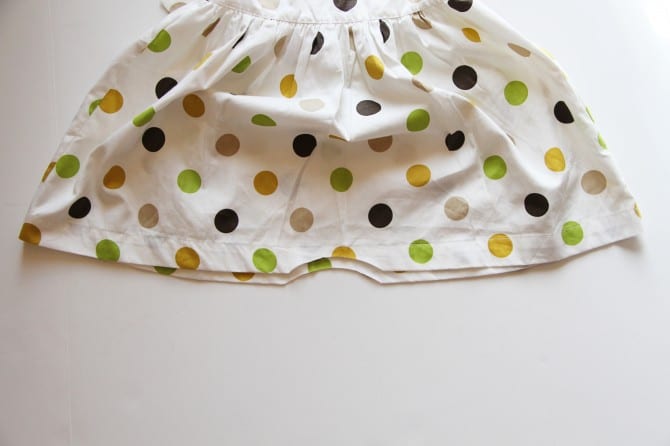
2. Then, cut out 2 curved strips of cotton fabric, that follow the bottom curve of the dress exactly. Make the width of the curved strips about 1 3/4 inch across, which includes a seam allowance. And also, let the bottom edge fall below the bottom edge of the dress by about a 1/4 inch (for a seam allowance).
YOU WILL NEED 2 of these curved strips for the front dress curve and 2 strips for the back dress curve.
3. Grab two of the strips and sew them together along the outer curve and along the bottom. I used a 1/4 inch seam allowance along the curve but then a 1/2 inch seam allowance along the bottom sides because I don’t want this lining piece to reach the very bottom of the dress and peek out from the front.
4. Then I trimmed off the extra seam allowance, trimmed off the 2 corners, then clipped the curve.
5. Then I turned it right side out, poked out the corners, then pressed the whole thing flat. Do the same thing with the other 2 curved strips so that you have two of these lining pieces shown below.
- Now, set those 2 lining pieces aside.
6. Next, you’re going to create a casing for the elastic at the bottom of the dress. Since you cut a curve into the bottom of the dress, that will be your entrance for your casing. So now, you need to sew a seam about 3/8 of an inch below the already existing hem of the dress. The top red arrow is showing my already existing hem seam. The bottom arrow is the new seam I sewed. Just be sure to not where the curve of the crotch is.
7. (Again, every dress hem is different. If you don’t have a large hem, you may not need to add another seam. Just use the hem as your casing. Or if you have a large hem like I do [about an inch] but don’t want the ruffle like I have, you can use wider elastic and thread it through and be done with it. I just wanted an elastic casing with a but of a ruffle below that.)
8. Next, thread some 1/4 inch elastic (or whatever size you want) into one of the casings, by attaching a safety pin to one end. Before pulling it all the way through, sew the one end of elastic in place. Then pull the elastic to cinch it in. (The amount of elastic depends on the size of your subject’s thigh. But be sure to add another inch to the length for a seam allowance.)
9. I sew the elastic in place with 2 seams, to secure it.
10. Do the same things to the other side. So now you have 2 cinched in legs.
- Next, the snaps.
11. Grab one of your curved lining pieces and lay it along the front curve of the dress. Center it and line up all the raw edges. And my bottom edges aren’t as long as the dress on purpose, because I didn’t want them to peek out from the front. Pin in place and sew along the curve. Then clip the curve.
12. Then flip that lining over and under and press flat. Then sew that pining piece in place.
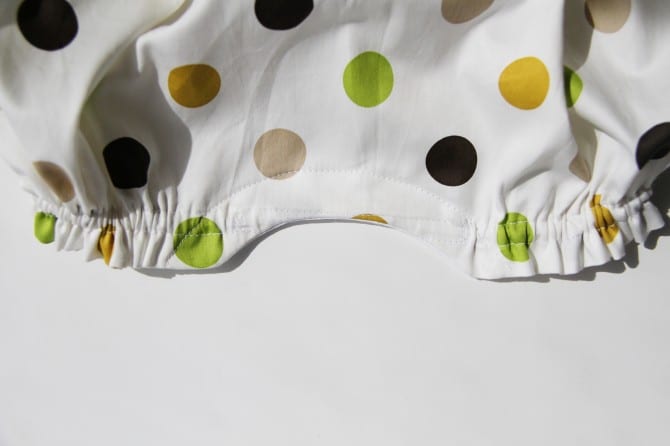
13. Here’s a view from the back.
(ALTERNATE METHOD: before sewing this flap down you could attach your snaps to this piece and then sew it down so that the snaps are only going through the lining piece and won’t show from the front side of the romper. I didn’t really think of that until too late. But doing this also makes it a little harder to sew the lining piece down if the snaps are in the way. You decide.)
(ALTERNATE METHOD: before sewing this flap down you could attach your snaps to this piece and then sew it down so that the snaps are only going through the lining piece and won’t show from the front side of the romper. I didn’t really think of that until too late. But doing this also makes it a little harder to sew the lining piece down if the snaps are in the way. You decide.)
14. Do the same thing to the back curve. Sew the curve down in place and clip.

15. But, then zig-zag those raw edges because these edges won’t be enclosed. Then flip it down and under and press flat, just like you did with the first one. Then fold your flap back and add your snaps to this flap piece. (You will have to match up your lining piece sections and place a pin where you want your snaps to go. Then just add them on.) YOU HAVE TO add the snaps to this flap piece ONLY and not through all of the layers because otherwise this crotch section will not lay flat while on baby.
16. This may sound confusing but the front snaps can go through all the layers but the back snaps can only go through this little flap. (Or vice versa if you want to the snaps to show from the back but not the front.)

17. Now, add your snaps to the front section, making sure they match up with the back section.
Here’s a view of both. The top snaps go through all the layers, but the bottom snaps are only through the white lining piece.
Here’s a view of both. The top snaps go through all the layers, but the bottom snaps are only through the white lining piece.
And that’s it! A new little romper from an old dress.
credits to: makeit-loveit.com


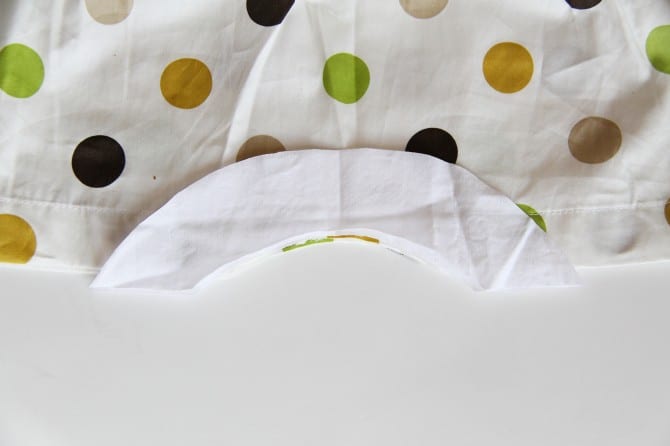








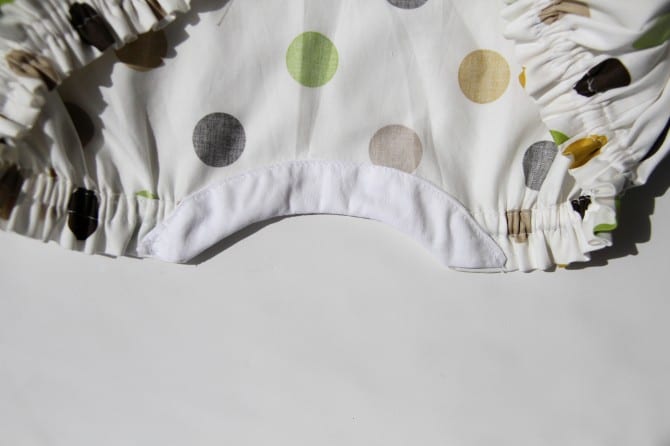
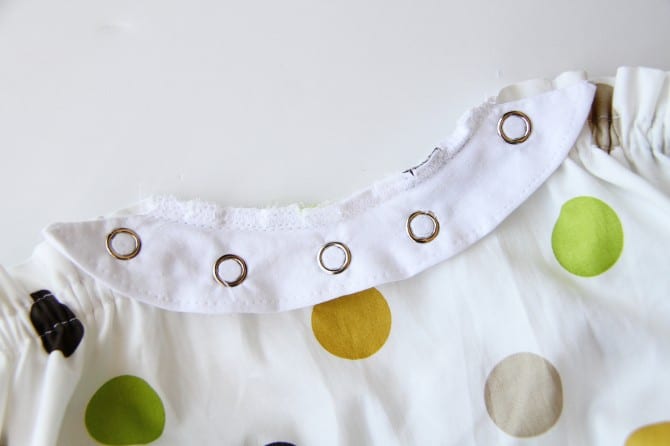


Comments
Post a Comment